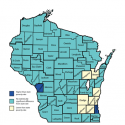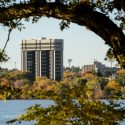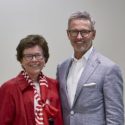UniverCity partners with Green County
UniverCity Year is traveling to Green County.
The UW–Madison program, aimed at improving the sustainability, resilience and livability of Wisconsin communities, will work with the south central Wisconsin county for the 2018-19 academic year and is seeking faculty who want to help strengthen the university’s connection with communities across the state.
“UniverCity Year helps faculty connect what students learn in the classroom to the real-world needs of our communities,” says UniverCity Year Program Manager Kelly Conforti Rupp. “Our staff work directly with local government leaders to identify projects based on the community’s annual plans and priorities. We also ensure that projects are rigorous, time bound and fit within a course’s learning outcomes.”
For its first year, UniverCity Year partnered with Monona, a city of about 7,500 just outside Madison. This year, it is working with the Dane County Board of Supervisors and will celebrate that partnership with an event in May.
After working with groups close to Madison, it was important to help the university collaborate with communities further away, Rupp says.
Green County, located in south central Wisconsin, is known for its rich agricultural history, pastoral scenery, and small-town atmosphere. Comprised of 16 towns, six villages, and two cities, it has a population of 36,842.
“We are most interested in projects that give students a direct opportunity to interact with citizens of our communities, so that they get a small taste of life in a rural community,” says Bryan Gadow, the New Glarus Administrator who is teaching an Urban and Regional Planning class already this semester as part of our partnership. “This includes working on updating park inventories, working on safe routes to school issues, and a wide assortment of community health related issues.”
Some of the other areas of interest include:
- Developing and analyzing quality of life metrics
- Attracting more businesses and residents to the area
- Designing communication and marketing plans
- Reviving downtowns
- Building hotels and community centers
- Improving parks and playgrounds
- Increasing physical activity and access to healthy food
- Developing breastfeeding resources and education
- Designing safe routes to school and other transportation plans
- Addressing the housing shortage
- Removing phosphorous and developing conservation plans
- Launching cooperatives and networks to support farmers
- Studying municipal staff workload and salary
“These projects not only help Green County communities, they will help students build their resumes and their experience,” says Cara Carper, executive director of the Green County Development Corp. “Not only will they get a front row seat into how rural communities work, they will have a seat at the table. These projects all have great community support and students and their input will be welcomed. Many of the projects have been simmering for years, but without community funding, they go nowhere. Students will have a huge impact on Green County and our region well into the future.”
UniverCity Year is based on the EPIC-N model, an initiative that started at the University of Oregon and has been adopted by more than 25 other universities. Leaders from those universities will be on campus in April when UW–Madison hosts the annual EPIC-N conference.
Tags: outreach




